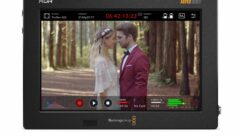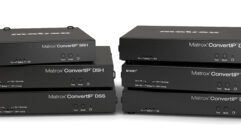
Video Review: Casio Super Bright XJ-S57
Dec 1, 2008 12:00 PM,
By Jeff Sauer
A high-brightness projector tucked into a small form factor.

Casio is probably not the company that first comes to mind when you think about projectors. Nor are you likely to think of projection before watches, calculators, and electronic pianos when you hear the name Casio. Yet over the last few years, Casio has quietly become a player in the business-projector sector — thanks in no small part to its expertise in miniature electronics and a broad distribution channel. Casio has also succeeded by finding a niche in increasingly bright small-form-factor projectors.
Casio’s newest models are the Super Bright XJ-S57 that I reviewed and the Super Color XJ-SC215. Both share the same super-slim form factor that is less than 2in. tall, and both are portable enough to slip into a briefcase or the extra pocket of a laptop case. Yet, at 3000 lumens and 2500 lumens, respectively, Casio’s projectors are now bright enough to be considered serious options for some installation environments where size matters. Obviously with such a tiny, slip-into-a-bag form factor, these probably should not be the first choice in situations where security concerns are high on the list. However, if you have a small space to work with, XJ-S57’s small profile might be just what you need.
It’s been just three years since Casio introduced its first data projectors, and they’ve always been slim — starting at just 2in. tall. The Super Slim brand has been around for two of those years; it boasts a height of only 1.7in. and a chassis that’s comparable to a notebook computer. Yet these projectors still deliver plenty of light for small conference rooms or classrooms.
Connections are on the XJ-S57’s back panel, but they are minimal and cater to the road warrior’s likely needs. There’s just one 15-pin D-sub RGB input and a combined AV input for composite video and audio, but there isn’t an S-Video input. On the other hand, like most projectors these days, the XJ-S57 can leverage an optional YUV-to-RGB splitter to input component video.
Casio does offer a USB port in the back (with a standard-sized USB port — no adapter needed) into which one can plug a USB thumb drive for PC-free presentations and image viewing. Casio has a straightforward interface that allows you to delve into any folders on an attached USB drive just as you would on a computer. It’s a nice feature for on-the-go presentations, for a visiting lecturer, or perhaps for a slide show of images or advertisements played at a nightclub or other entertainment venue or retail establishment. Casio also includes a serial port — which requires the included adapter — that affords external control of the projector.
Quite surprisingly for a projector this small, Casio has given the XJ-S57 powered zoom and powered focus, which could be of great assist during installation if the projector is on or near the ceiling. If the projector will be moving around from room to room or city to city with a traveling presenter, Casio has included effective quick-adjustment and auto-keystone features that allow for very fast setup prior to operation.
Naturally, with a name like Super Bright, Casio is drawing a proverbial line in the sand on what’s most important in the S57. I measured 2742 peak lumens in the center of the image and 2698 ANSI lumens across in the entire screen. That’s about 10 percent lower than Casio’s claim of 3000 lumens — although that discrepancy is better than the embarrassing industry practice of 15 percent to 20 percent spec exaggeration. Even better, the variation between that center-spot brightness and the overall brightness across the screen represents a brightness uniformity of more than 92 percent. That’s very impressive for such a small-form-factor projector, and that’s a good reason that it could step into the role of a conference-room or classroom projector if installation space is tight.
Video Review: Casio Super Bright XJ-S57
Dec 1, 2008 12:00 PM,
By Jeff Sauer
A high-brightness projector tucked into a small form factor.
Similarly, the S57’s scaling was very good, but only if the source was XGA or SXGA. With higher- and lower-resolution sources, I noticed more artifacts on fine text and images than I would like. Of course, XGA and SXGA are likely to be the most common resolutions that the projector is called on to display.
I measured an impressive contrast ratio of 1463:1 in Presentation mode; this was again less than what the company claimed, but it’s within an industry margin of error and effective enough in its own right. The S57’s grayscale ramp was also fairly good, particularly for a high-brightness projector, with only a little of an “S” shape at the top between 90 IRE and 100 IRE. On the other hand, color temperature was variable with a range of more than 1000K as brightness increased from black to white. Clearly, that’s an effort to compensate for the extra light that Casio is moving through the projector.
Color performance was something of a mild surprise, at least in terms of accuracy. Green was a little undersaturated and blue was a little toward green, but red was right on in my tests. The secondary colors of yellow, magenta, and cyan were surprisingly good for a high-brightness projector. The caveat is that while the color is fairly accurate, saturated colors dramatically limit the light output of the projector by negating the huge white section of the color wheel. The sum brightness of pure red, blue, and green measures was less than 50 percent of the brightness of white.
Of course, Casio bills the XJ-S57 as the Super Bright model, and it has a second Super Color model that could be a better choice if the use will be more heavily oriented toward displaying photographs and other colorful images. The Super Color model uses a six-segment color wheel that includes red, green, blue, yellow, cyan, and white — but even with that model, the white section is the largest of the six.
Casio has been building a projector brand that focuses on road-warrior presenters and that leverages a very slight form factor that can be slipped into a bag and carried anywhere. However, that same super-slim form factor, high brightness, and a few helpful setup features — such as powered focus and zoom, serial control, and a USB viewer — could make the XJ-S57 and its Super Color sibling very practical and low-cost installation projectors as well.
PRODUCT SUMMARY
- Company: Casio
www.casio.com - Product: Super Bright XJ-S57
- Pros: High brightness in a small form factor, good sharpness at either XGA or SXGA, powered focus and zoom.
- Cons: Very limited connectivity, poor color temperature across grayscales.
- Applications: Installation environments where size matters.
- Price: $1,599.99
SPECIFICATIONS
- Resolution: XGA (1024×768)
- Brightness: 3000 ANSI lumens
- Contrast: 1800:1 full on/off
- Native resolution: SXGA+ (1400×1050)
- Configuration: 1×0.55in. DMD
- Light source: 210W high-pressure mercury lamp (rated up to 2000 hours)
- Zoom: 2X powered
- Projection distance: 2.8ft.-18.4ft.
- Screen size: 15in.-300in. diagonal
- Throw ratio: 1.4-2.8:1
- Lens shift: 10:0
- Keystone: ± 30° vertical
- Loudspeakers: 1W mono
- Dimensions: 10.7″×1.7″×7.8″ (W×H×D)
- Weight: 3.97lbs.
- Warranty: Three years parts and labor, 120 days lamp










